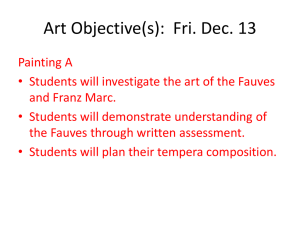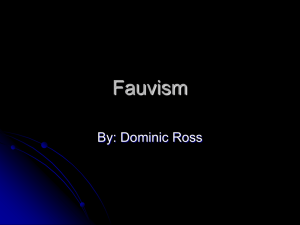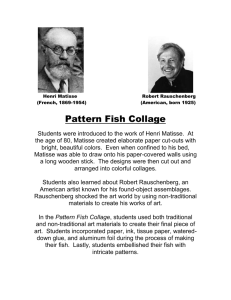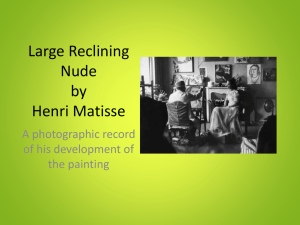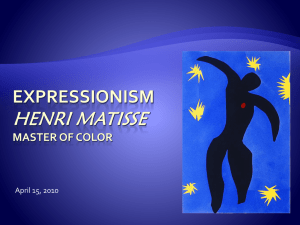Matisse
advertisement
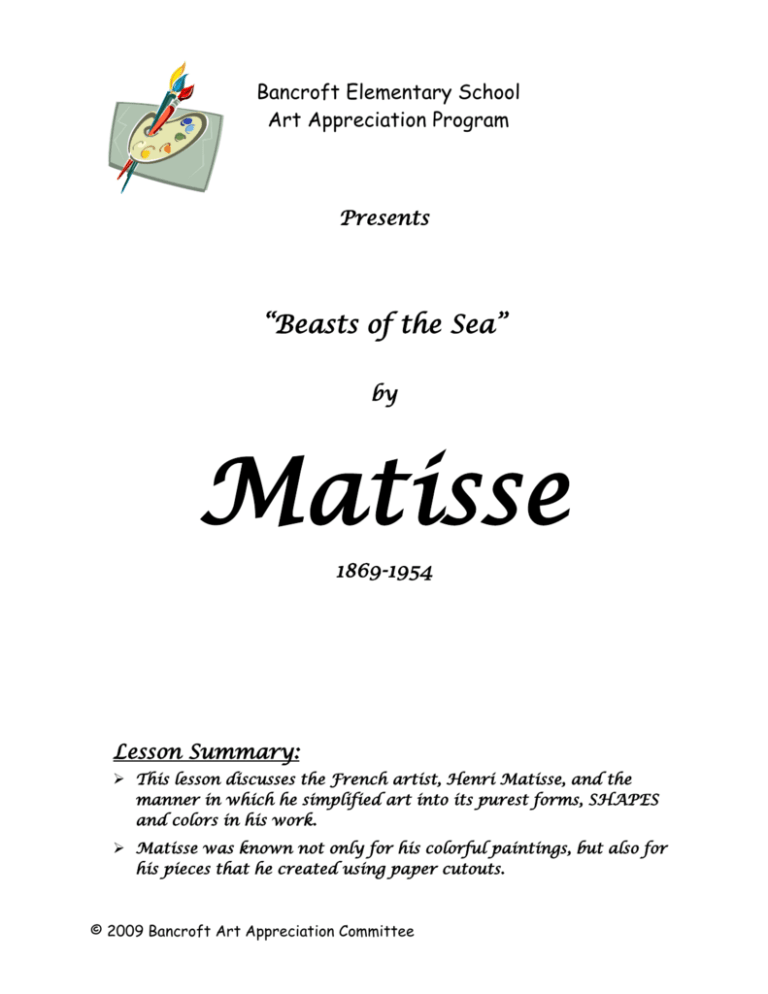
Bancroft Elementary School Art Appreciation Program Presents “Beasts of the Sea” by Matisse 1869-1954 Lesson Summary: This lesson discusses the French artist, Henri Matisse, and the manner in which he simplified art into its purest forms, SHAPES and colors in his work. Matisse was known not only for his colorful paintings, but also for his pieces that he created using paper cutouts. © 2009 Bancroft Art Appreciation Committee VOLUNTEER CHECKLIST Lesson Information Artist: Henri Matisse (1869-1954) Art Title: “Beasts of the Sea” Period or Style: Fauvism Art Element: Shape Project/Medium: Creating cut-out creation with paper Prep-work Required Discussion: Familiarize yourself with current lesson details Art Activity: PRE-CUT colored construction paper in different size rectangles, Presentation Materials Slides: Madame Matisse; Woman in Purple Coat; Electronic on Lagoon; Creole Dancer; Beasts of the Sea; thumb drive in The Sorrows of the King. Cabinet Lesson Plan: Matisse In folder Background Info: Getting to Know the World’s Greatest Artists book; In folder Activity Materials 8x11 ½ white cardstock paper 1 sheet per student Black, pink, red, light and dark blue, yellow, light green and purple construction paper for cut-out shapes (any colors OK) Pre-cut rectangles for each student Variety of colorful PRE-CUT spirals (optional) 1 per student Pencils, scissors, glue sticks Enough for all Templates/stencils (in folder) Students share © 2009 Bancroft Art Appreciation Committee 2 MATISSE LESSON PLAN Lesson Objectives: To introduce students to the life of French artist, Henri Matisse, a well-known artist from the “Fauves” period, which means “wild men.” Matisse was especially well known for his use of vibrant colors. He was also well known for his later work in which used paper cutout SHAPES to create his pieces. Presentation Timing With lower grade students, it is important that you KEEP THE ARTIST DISCUSSION SIMPLE. Remember; spend 20% on the discussion portion and 80% on the art activity. Fauvism Fauvism was a new art movement that was inspired by the art of Vincent Van Gogh, Gauguin and Paul Cezanne. Henri Matisse originated fauvism and the first Exhibit of their works was in 1905 in Paris. (Show Madame Matisse, Portrait with Green Stripe) To the Fauves, color no longer was used to describe an object; colors were chosen arbitrarily to express emotion. ‘Fauves’ in French means wild beasts. When they exhibited for the first time it was in a gallery among classical sculptures, including the Renaissance artist Donatello. Seeing these wildly colored paintings among the sculptures one critic was quoted as saying, ‘It was like seeing Donatello among the wild beasts’. After this the name Fauves stuck. Fauvism was the dominant trend in the Paris art scene until 1908. © 2009 Bancroft Art Appreciation Committee 3 Henri Matisse Henri Matisse was born in northern France in 1869. Who knows where France is (show map)? He was studying to become a lawyer and fell ill. While he was recovering his mother brought him a box of points to keep him entertained and he was hooked. As soon as he was well he decided to give up Law and trained to become an artist. Early in his career he started the Fauvist movement with a group of other artists in Paris and explored using expressive color. In 1917 he moved to the south of France in Nice where his celebration of color reached its peak. He loved the sun- drenched coastline and it brought much inspiration to his paintings. (Show Woman in Purple Coat) In 1941 Matisse was diagnosed with cancer and became confined to a wheelchair. As Matisse got older and it became difficult to stand at an easel he began to ‘paint with scissors’ He created paper cuts, carving in colored paper, scissoring out shapes and collaging them into bright compositions. (Show Lagoon, Creole Dancer) At the age of 80 he created this piece in memory of the South Seas he visited 20 years before. (Show Beasts of the Sea) It shows a wonderful underwater world full of sea cucumbers, fish, sea horses and waterweeds. At the age of 82 he created this piece. (Show The Sorrows of the King) This collage actually is as large as a wall. It shows a king sitting on a raised platform, playing a guitar. Another musician crouches at his feet and a woman dances before them. The colorful patterns create a cheerful effect-like you can hear the music being played which distracts the King from his sorrows. Matisse continued to experiment with color until his death at the age of 84. © 2009 Bancroft Art Appreciation Committee 4 Art Activity BEFORE CLASS PREP WORK: Volunteer pre-cuts a variety of colors of construction paper into different size rectangles, some larger for background 4x4 and other sizes for other shapes. Show the students the project example inspired by Matisse’s ‘Beasts of the Sea’. Show how the background colors are greens and blues of the sea and yellows toward the top closer to the sunshine and different plants and a fish decorate on top. Encourage students to create a sea scene or a musical celebration scene using different colored cutouts. Tell them to use the scraps from their cut out shape as well and incorporate it into the design in a pleasing way. Matisse often used the negative scrap along with the cut out shape in his compositions-they belong together. Hand out a piece of white cardstock paper and have students put their name and teacher’s name on the back. Have a variety of colored paper and glue sticks and scissors on each table. Encourage them to create a variety of shapes: triangles, zigzags, plants, leaves and swirls etc. There are some templates to use if children need help. Students can now glue down the pieces (glue sticks). Upon gluing, it is helpful to have a sheet of “scrap” paper to lay under the piece to be glued. It prevents glue from sticking all over the desk. When the students are finished collect and store safely until the end of the year. © 2009 Bancroft Art Appreciation Committee 5
